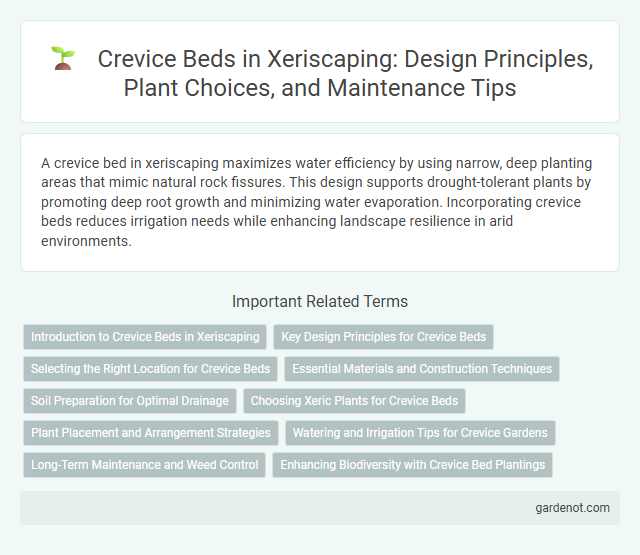A crevice bed in xeriscaping maximizes water efficiency by using narrow, deep planting areas that mimic natural rock fissures. This design supports drought-tolerant plants by promoting deep root growth and minimizing water evaporation. Incorporating crevice beds reduces irrigation needs while enhancing landscape resilience in arid environments.
Introduction to Crevice Beds in Xeriscaping
Crevice beds in xeriscaping create narrow, deep planting areas that mimic arid rock fissures, optimizing water efficiency and promoting drought-resistant vegetation. These beds are constructed with well-draining soil and strategically placed crevices to channel moisture directly to plant roots, reducing evaporation. Ideal for succulents and alpine plants, crevice beds enhance landscape design while conserving water in dry climates.
Key Design Principles for Crevice Beds
Crevice beds prioritize narrow, deep planting spaces to mimic natural rock fissures, enhancing water retention and root protection in xeriscape gardens. Key design principles include using well-draining, gritty soil mixes and selecting drought-tolerant plants with deep rooting systems that thrive in confined crevices. Proper spacing and alignment of crevices optimize airflow and sunlight exposure, crucial for plant health and minimizing water evaporation.
Selecting the Right Location for Crevice Beds
Choosing the ideal location for crevice beds involves selecting areas with excellent drainage and ample sunlight, as these conditions mimic the natural rocky habitats where crevice plants thrive. Positioning the bed on slopes or raised mounds enhances drainage, preventing water accumulation that can damage roots. Avoid low-lying or heavily shaded spots to ensure optimal growth and health of specialized xeriscape plants adapted to crevice environments.
Essential Materials and Construction Techniques
A crevice bed in xeriscaping requires essential materials such as well-draining soil composed of sandy or gritty substrates mixed with organic matter to ensure optimal moisture retention and aeration. Construction techniques involve creating deep, narrow fissures or crevices using stone slabs or rocks arranged in tight clusters to mimic natural rocky habitats, promoting drought-resistant plant growth. Proper layering and strategic placement of plants like succulents and alpine species enhance water efficiency and overall bed durability.
Soil Preparation for Optimal Drainage
Crevice beds require well-draining soil composed of a coarse, sandy substrate mixed with organic matter to prevent water retention. Incorporating gravel or small rocks enhances aeration and mimics natural cliff crevices, promoting root health. Proper soil preparation reduces the risk of root rot and supports drought-tolerant plants essential for successful xeriscaping.
Choosing Xeric Plants for Crevice Beds
Selecting xeric plants for crevice beds requires prioritizing species with deep root systems and high drought tolerance, such as sedums, succulents, and native grasses, which thrive in narrow, rocky environments. Opt for plants like Delosperma, Sempervivum, and certain drought-resistant ferns that can anchor securely in the crevices while minimizing water needs. Proper plant choice enhances soil stability, reduces irrigation demands, and supports sustainable xeriscape landscapes.
Plant Placement and Arrangement Strategies
Crevice beds optimize plant placement by mimicking natural rock fissures, providing deep, well-drained spaces ideal for drought-tolerant species such as sedum, sempervivum, and dwarf conifers. Positioning plants with varying water needs at different depths within the crevices enhances microclimate adaptation and reduces irrigation requirements. Arranging species according to sun exposure and root structure maximizes growth efficiency and preserves soil moisture in xeriscape gardens.
Watering and Irrigation Tips for Crevice Gardens
Crevice beds require minimal watering due to their design, which mimics natural rock fissures and promotes efficient water retention. Irrigation should prioritize deep, infrequent soaking to encourage deep root growth and prevent surface evaporation. Using drip irrigation or soaker hoses ensures precise water delivery, maintaining moisture levels without overwatering in xeriscape crevice gardens.
Long-Term Maintenance and Weed Control
Crevice beds require minimal long-term maintenance due to their well-draining, nutrient-poor soil that naturally discourages weed growth. Strategic plant placement and the use of gravel or stone mulch further suppress weed emergence and reduce watering frequency. Over time, these beds promote sustainable xeriscaping by conserving water and reducing labor-intensive upkeep.
Enhancing Biodiversity with Crevice Bed Plantings
Crevice bed plantings create narrow, deep soil gaps that mimic natural rock formations, providing ideal microhabitats for drought-tolerant and native xeriscape plants. These specialized planting pockets support diverse root systems and moisture retention, promoting a wide variety of flora and fauna adapted to arid environments. Integrating crevice beds enhances biodiversity by offering shelter and resources for pollinators, beneficial insects, and small wildlife within sustainable xeriscape landscapes.
Crevice bed Infographic

 gardenot.com
gardenot.com